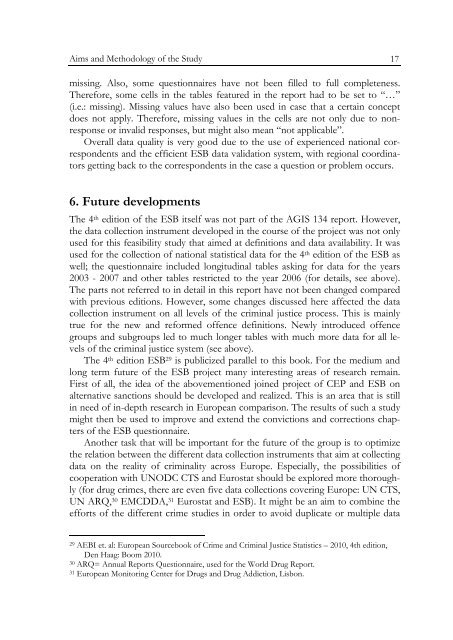Defining and Registering Criminal Offences and Measures - Oapen
Defining and Registering Criminal Offences and Measures - Oapen
Defining and Registering Criminal Offences and Measures - Oapen
You also want an ePaper? Increase the reach of your titles
YUMPU automatically turns print PDFs into web optimized ePapers that Google loves.
Aims <strong>and</strong> Methodology of the Study 17<br />
missing. Also, some questionnaires have not been filled to full completeness.<br />
Therefore, some cells in the tables featured in the report had to be set to “…”<br />
(i.e.: missing). Missing values have also been used in case that a certain concept<br />
does not apply. Therefore, missing values in the cells are not only due to nonresponse<br />
or invalid responses, but might also mean “not applicable”.<br />
Overall data quality is very good due to the use of experienced national correspondents<br />
<strong>and</strong> the efficient ESB data validation system, with regional coordinators<br />
getting back to the correspondents in the case a question or problem occurs.<br />
6. Future developments<br />
The 4 th edition of the ESB itself was not part of the AGIS 134 report. However,<br />
the data collection instrument developed in the course of the project was not only<br />
used for this feasibility study that aimed at definitions <strong>and</strong> data availability. It was<br />
used for the collection of national statistical data for the 4 th edition of the ESB as<br />
well; the questionnaire included longitudinal tables asking for data for the years<br />
2003 - 2007 <strong>and</strong> other tables restricted to the year 2006 (for details, see above).<br />
The parts not referred to in detail in this report have not been changed compared<br />
with previous editions. However, some changes discussed here affected the data<br />
collection instrument on all levels of the criminal justice process. This is mainly<br />
true for the new <strong>and</strong> reformed offence definitions. Newly introduced offence<br />
groups <strong>and</strong> subgroups led to much longer tables with much more data for all levels<br />
of the criminal justice system (see above).<br />
The 4 th edition ESB 29 is publicized parallel to this book. For the medium <strong>and</strong><br />
long term future of the ESB project many interesting areas of research remain.<br />
First of all, the idea of the abovementioned joined project of CEP <strong>and</strong> ESB on<br />
alternative sanctions should be developed <strong>and</strong> realized. This is an area that is still<br />
in need of in-depth research in European comparison. The results of such a study<br />
might then be used to improve <strong>and</strong> extend the convictions <strong>and</strong> corrections chapters<br />
of the ESB questionnaire.<br />
Another task that will be important for the future of the group is to optimize<br />
the relation between the different data collection instruments that aim at collecting<br />
data on the reality of criminality across Europe. Especially, the possibilities of<br />
cooperation with UNODC CTS <strong>and</strong> Eurostat should be explored more thoroughly<br />
(for drug crimes, there are even five data collections covering Europe: UN CTS,<br />
UN ARQ, 30 EMCDDA, 31 Eurostat <strong>and</strong> ESB). It might be an aim to combine the<br />
efforts of the different crime studies in order to avoid duplicate or multiple data<br />
29 AEBI et. al: European Sourcebook of Crime <strong>and</strong> <strong>Criminal</strong> Justice Statistics – 2010, 4th edition,<br />
Den Haag: Boom 2010.<br />
30 ARQ= Annual Reports Questionnaire, used for the World Drug Report.<br />
31 European Monitoring Center for Drugs <strong>and</strong> Drug Addiction, Lisbon.

















